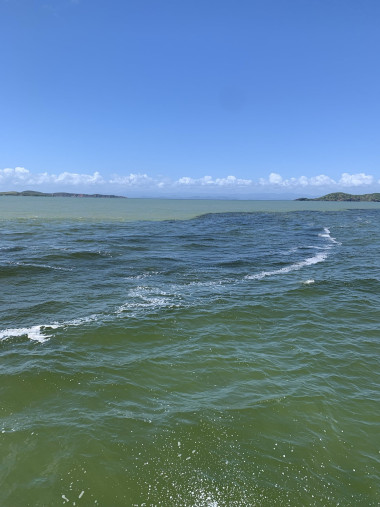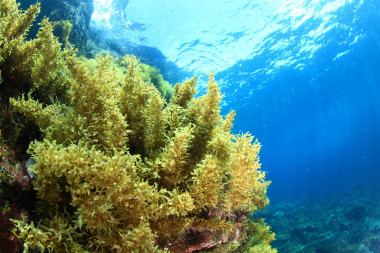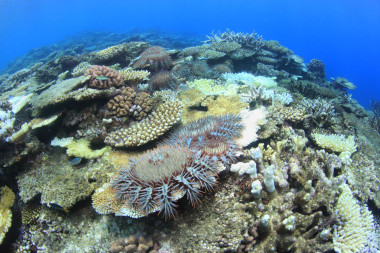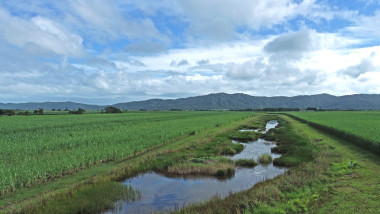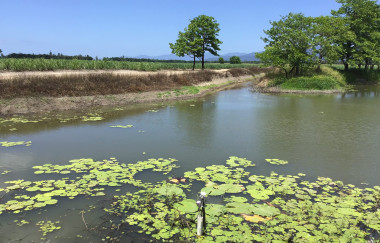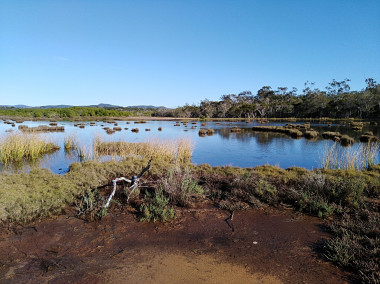Nutrients occur naturally in ecosystems, however anthropogenic activities have increased the amount of nutrients reaching Great Barrier Reef ecosystems mostly through land-based runoff, with impacts that vary in extent and severity depending on the ecosystem and distance from the coast. Across the Great Barrier Reef, a 60% reduction in the 2009 anthropogenic end-of-catchment dissolved inorganic nitrogen loads is required to meet the 2025 targets defined in the Reef 2050 Water Quality Improvement Plan. Substantial effort is required to meet these targets, especially in the basins delivering the largest dissolved inorganic nitrogen loads to the Great Barrier Reef, particularly in the context of other increasing stressors including climate change.
Scope
The diagram below shows the scope of the dissolved nutrients theme. It represents the Great Barrier Reef catchment and marine environment and shows the ecological impacts of nutrients on aquatic ecosystems and biota including the influence of flood plumes which mostly affect inshore and midshelf areas. The primary source of dissolved nutrients is sugarcane, with much smaller contributions from urban land uses, bananas and other horticulture, but these can be locally important. Transport pathways are also shown for nitrogen and phosphorus. Nutrients are transported from the catchment to the Great Barrier Reef mostly through surface runoff, subsurface drainage and groundwater movements, with volumes and frequency influenced by rainfall, fertiliser application, erosion and river transport times. Examples of potential management practices to minimise dissolved nutrient export are synthesised and include reducing fertiliser application rates and reviewing the role of wetlands and other vegetation as measures for reducing nutrient export to the Great Barrier Reef.
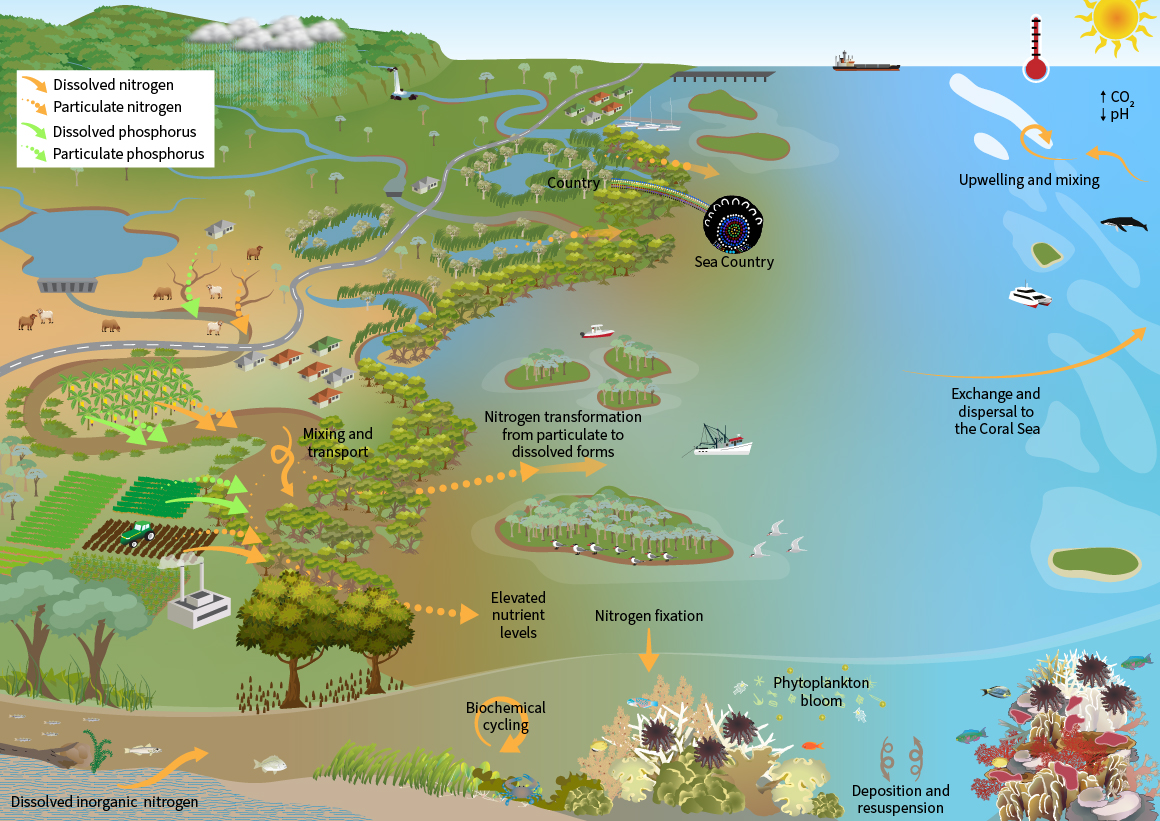
Context
Nutrients occur naturally in ecosystems, however anthropogenic activities have increased the amount of nutrients reaching Great Barrier Reef ecosystems mostly through land-based runoff, with impacts that vary in extent and severity depending on the ecosystem and distance from the coast. Across the Great Barrier Reef, a 60% reduction in the 2009 anthropogenic end-of-catchment dissolved inorganic nitrogen loads is required to meet the 2025 targets defined in the Reef 2050 Water Quality Improvement Plan. Substantial effort is required to meet these targets, especially in the basins delivering the largest dissolved inorganic nitrogen loads to the Great Barrier Reef, particularly in the context of other increasing stressors including climate change.
The synthesis of the evidence for dissolved nutrients included a total of 1,272 studies extracted and synthesised for 9 questions (with some overlap in the evidence between questions). This theme reviews the evidence of the causal relationships between impacts, sources and management of nutrients (with a focus on dissolved forms of nitrogen and phosphorus) influencing the Great Barrier Reef. The theme starts with the evidence of the ecological processes within the Great Barrier Reef including the spatial and temporal distributions of dissolved nutrients and associated indicators (Q4.1), and the measured impacts of those nutrient loads on Great Barrier Reef ecosystems (Q4.2), with a specific question on the key drivers of the population outbreaks of crown-of-thorns starfish, including the contribution of nutrients from land-based runoff and alternative hypotheses (Q4.3). The primary sources of anthropogenic dissolved nutrients are presented (Q4.4), with expansion of the evidence of the biophysical drivers, transport and delivery processes from the catchment area to the Great Barrier Reef (Q4.5). Synthesis of the most effective management practices for reducing dissolved nutrient export from the Great Barrier Reef catchment area provides insights for policy and management (Q4.6). Finally, three questions focus on different aspects of wetlands and their potential role in improving water quality, including their efficacy (Q4.7), costs and cost drivers (Q4.8) and potential ecosystem services (Q4.9). The question addressing crown-of-thorns starfish outbreaks (Q4.3) and the wetland questions (Q4.7, 4.8 and 4.9) were identified by policy representatives as very high priority for clarifying the weight of evidence in a consistent and non-biased way due to increasing stakeholder interest in future investment programs.
Summary statement for Dissolved nutrients
The synthesis of the evidence for dissolved nutrients included a total of 1,272 studies extracted and synthesised for 9 questions (with some overlap in evidence between questions). The Summary Statement was developed using the evidence base from the nine questions in this theme. Convergence was reached for this Summary Statement among all authors within the Expert Group for this theme.
The summary of findings relevant to policy or management action for dissolved nutrients are:
- Nutrients, especially nitrogen and phosphorus, play a crucial role in the water quality and overall health of Great Barrier Reef ecosystems, supporting corals reefs, seagrass meadows and fisheries. Nitrogen is generally considered the major limiting nutrient in marine waters, both globally and in the Great Barrier Reef, however, phosphorus can limit primary productivity at certain times and locations. Multiple lines of evidence demonstrate that nutrient concentrations originating from land-based activities follow a cross-shelf gradient with the highest concentrations found in estuaries and inshore waters, and lower values in midshelf and offshore waters. Peak concentrations are usually found during the wet season (December to May), between Cooktown and Gladstone, adjacent to areas of more intensive catchment development and in waters influenced by river discharge. Weather patterns, river discharge and associated land-based inputs, as well as marine processes such as upwelling and nitrogen fixation are among the key drivers of nutrient variability, with oscillations over time. [Q4.1]
- Excessive amounts of dissolved inorganic nutrients can have detrimental effects on Great Barrier Reef ecosystems. In coral reefs, the most severe impacts may be indirect, for instance, excess nutrient availability on inshore reefs is generally (but not always) positively correlated with increased fleshy macroalgal abundance which can reduce coral settlement and recruitment, outcompete corals, reduce coral cover and negatively affect coral calcification. Excess nutrients might also contribute to coral-eating crown-of-thorns starfish outbreaks (see below). Direct effects of elevated nutrients include reduced coral calcification, negative impacts on coral reproduction, and potentially reducing thermal tolerance to bleaching. [Q4.2]
- There is no clear evidence of direct negative impacts of increased dissolved inorganic nutrients on seagrass ecosystems, and although elevated nutrients may be beneficial for mangrove growth, they can interact with climate stressors such as drought (low rainfall and low humidity) causing mangrove decline. There is limited evidence of the impact of dissolved inorganic nutrients on Great Barrier Reef wetland ecosystems. [Q4.2]
- During high river discharge events, elevated nutrient levels cause phytoplankton blooms that sometimes coincide with developing crown-of-thorns starfish larvae. These blooms increase the amount of food available for larvae which can increase survival, growth, and development rates, though it has not yet been shown that crown-of-thorns starfish outbreaks are limited by larval supply. Crown-of-thorns starfish outbreaks in the Great Barrier Reef start on midshelf reefs between Cairns and Lizard Island –the crown-of-thorns starfish ‘initiation area’, which occasionally receives nutrient-enriched flood plumes from rivers. Although land-based nutrient runoff may contribute to outbreaks, other factors such as marine upwelling, life history traits including high fecundity, and the effect of predator removal (e.g., fishing) may also be important. Combining evidence from these different factors will contribute to a more complete understanding about when, where and how population outbreaks will occur. [Q4.3]
- Overall, exports of anthropogenic dissolved inorganic nitrogen are twice as high as pre-development rates, mainly as a result of fertiliser-adding land uses. The Herbert, Burdekin, Fitzroy, Johnstone, Mulgrave-Russell, Tully and Haughton basins are the largest exporters of total dissolved inorganic nitrogen to the Great Barrier Reef (exporting over 500 tonnes per year, each). [Q4.4]
- Anthropogenic exports of dissolved inorganic nitrogen are greatest in basins dominated by sugarcane including those in the Wet Tropics, Burdekin and Mackay Whitsunday Natural Resource Management regions. Increased erosion from grazing and other land uses can also contribute to nutrient export, with transformation of particulate nutrients to dissolved form (termed bioavailable nutrients) during transport. Other land uses including urban, bananas and other horticulture contribute smaller amounts but can be locally important. Surface runoff, subsurface movement and groundwater are all significant transport pathways of dissolved nutrients to the Great Barrier Reef. Most export occurs in the wet season, with chronic and continuously high exports in wet tropical catchments. [Q4.4, Q4.5]
- Primary biophysical drivers of anthropogenic dissolved nutrient exports to the Great Barrier Reef are fertiliser application, altered catchment hydrology leading to changed (typically shorter) water residence times in rivers and reduced interaction of surface and subsurface runoff with floodplains, and erosion. Increased rates of fertiliser application and low nutrient use efficiency, increased cultivation area, low efficiency irrigation systems and heavy rainfall can lead to increased nutrient export, especially nitrogen, in surface and subsurface runoff and groundwater. [Q4.5]
- During river transport, nutrients can be transformed by a range of processes such as denitrification, desorption of nutrients from soil particles, plant uptake and burial, remineralisation, and deposition to sediment. However, the majority of nutrient loads are delivered from the source to the Great Barrier Reef World Heritage Area. The Reef Water Quality Report Card 2020 estimates that ‘Moderate’ overall progress has been made toward meeting the dissolved inorganic nitrogen load reduction targets. The monitoring program should be able to start detecting these improvements to export loads; however, for some management actions it may be several years until the benefits of management are fully realised. [Q4.4, Q4.5]
- The most effective and profitable management practice for reducing dissolved nitrogen exports from the Great Barrier Reef catchment area is reducing nitrogen fertiliser applications to industry recommended rates, with consistent results across different land uses, climates, and management contexts. Further rate reductions give consistent water quality benefits, but productivity and profitability varies. In sugarcane, other management practices include the use of Enhanced Efficiency Fertiliser, mill mud application, improved irrigation, crop residue management, improved farming systems (such as growing legumes in between sugarcane crops) and burying fertiliser. For many of these management practices, the effectiveness and profitability is not clearly demonstrated and, for some, varies depending on climate, soil and seasonal characteristics. The effectiveness and profitability of practices for reducing dissolved phosphorus exports are less clear, as is the situation for crops other than sugarcane. The adoption of management practices can be enhanced by a range of factors as discussed in detail in the theme on human dimensions of water quality improvement. [Q4.6]
- For urban and non-agricultural land uses, structural measures that include vegetation or biological components such as constructed wetlands, biofilters, algal ponds and existing riparian zones have considerable potential for removal of diffuse runoff nutrients and may also be important for management of wastewaters. Improvements in technologies for wastewater management also show that systems such as membrane filtration and chemical addition are likely to perform well. Non-structural controls such as policy, planning, regulation and compliance appear to work best when applied as part of an integrated approach, and recycling and reuse show considerable potential. [Q4.6]
- The global evidence indicates that tropical wetland systems can retain, process and in some cases, export nutrients, sediments and pesticides with a wide-ranging capacity for pollutant retention. The evidence also shows that natural and near-natural wetlands are typically more effective at nutrient removal (certain forms) and pesticide removal than constructed or restored wetlands, and sediment is often retained in wetlands but can be remobilised in large flow events. There are few peer reviewed studies that comprehensively measure or model wetlands’ efficacy or costs of water quality improvement in the Great Barrier Reef catchment area. Critical factors for optimising the efficacy of water quality improvement include: the presence and maintenance of vegetation communities; hydrological characteristics including the wetland size relative to the contributing catchment area, flow rate, loss pathways and water residence times; and the type, form and input concentration of the targeted pollutant. Available evidence indicates that the costs of treatment wetlands are highly variable. These factors, and the need for ongoing maintenance, need to be carefully considered when planning for the use of wetland systems as a water quality improvement tool in the landscape. [Q4.7, Q4.8]
- Natural and near natural wetlands provide many benefits to society and the environment including regulating ecosystem services such as improved water quality and carbon sequestration, supporting services such as nutrient cycling and provision of habitat, cultural services such as aesthetics and recreation and provisioning services including food, water and other resources. In the Great Barrier Reef catchment area, these wetlands and services are under pressure due to expansion of coastal agriculture, urban and industrial development. Wetlands can be restored to enhance water quality benefits but without a long-term plan of maintenance, and clear definition of restoration goals, restoration project sites have a high risk of returning to a degraded state, reducing the services they provide. The historical loss of natural wetlands across floodplains and the degradation of those ecosystems remaining are important considerations for determining future protection and management opportunities for wetlands in the Great Barrier Reef catchment area. [Q4.7, Q4.9]
Confidence
The confidence rating of the questions was High for one question (addressing the sources of dissolved nutrients), and Moderate for the remaining eight questions, mostly explained by Moderate relevance of the evidence to the question for studies that were not originally designed to address some of the questions, and Moderate consistency as a result of alternate hypotheses or where less evidence was available. The Moderate ratings for relevance and consistency also reflect the considerable natural variability in sources of nutrients, in the very diverse organisms that constitute the various Great Barrier Reef ecosystems and their variable responses.
Strength of evidence
The findings in this theme are underpinned by a large body of evidence, including multiple lines of evidence (including monitoring, modelling, remote sensing, meta-analysis, experimental research and observations). The strength of evidence across this theme, considering the confidence, quantity and diversity of study types, is considered to be Moderate, with limited evidence around wetland systems, and on nutrient management options beyond those related to sugarcane.
Key uncertainties
The key uncertainties of the evidence identified dissolved nutrients relevant to policy and management include the following: effects of increased dissolved inorganic nutrients on freshwater streams and wetlands in the Great Barrier Reef catchment area; the magnitude and distribution of nitrogen fixation in wetlands, coastal and marine waters; the relative importance of the hypothesis explaining the occurrence of crown-of-thorns starfish outbreaks; the interactions between elevated nutrients and other stressors on the ecosystems including climate change factors such as warming and ocean acidification; understanding of nutrient transformations to better assess the effectiveness of management actions; accounting for variability and unpredictability in the effectiveness of management practices for reducing dissolved inorganic nitrogen in sugarcane and other crops; the management of dissolved phosphorus discharges from all agricultural land uses; the heterogeneity in cost data depending on agro-ecological, social and economic factors; and the contribution of groundwater to nutrients entering and being processed in wetlands which is likely to be an important consideration when evaluating their performance in pollutant removal.
Recent findings
Recent findings continue to identify fertiliser inputs, erosion, surface runoff and rainfall as key factors influencing nutrient concentrations in freshwater, and there has been an increased understanding of the transformation from particulate to dissolved form (termed bioavailable nutrients). In terms of dissolved nutrient impacts on ecosystems, while there has been limited new research since 2016, investigations have focused on the combined effects of nutrients with other climate change-related pressures including warming, and ocean acidification, and the relationship between elevated nutrients and macroalgae. The combined impacts of multiple factors that contribute to crown-of-thorns starfish outbreaks, and the role of anthropogenic nutrient inputs in this context, is now better understood, however new research has also highlighted the complexity and variability of these interactions. In the catchment, the potential benefits of Enhanced Efficiency Fertiliser application in sugarcane have been clarified, and knowledge of the interactions between climate and fertiliser dynamics is improving. New research has begun to assess the effectiveness of wetland and treatment systems for water quality improvement in agricultural areas.
Knowledge gaps
For dissolved nutrients, the areas where further knowledge is needed that are most relevant to policy and management include:
- A more complete picture of nutrient sources and distributions in the Great Barrier Reef (e.g., dissolved inorganic nitrogen from the Fitzroy region, and potential links to soil erosion) including temporal and spatial variability, nutrient budgets, links to land-based inputs, outcomes from management changes, and timescales for change.
- The role of oceanographic processes in driving variability in marine nutrient concentrations.
- Links between elevated nutrients and other ecosystem impacts such as bleaching, coral disease, microbioerosion and microbial communities.
- The effects of increased dissolved inorganic nutrients on freshwater streams and wetlands.
- Factors contributing to crown-of-thorns starfish outbreaks including demography, ecology, reproductive potential and recruitment limitations, feeding rates and predation rates.
- Transformation processes, export and impacts of phosphorus in all ecosystems.
- Quantification of the generation of bioavailable nutrients from soil erosion and the timeframes of nutrient transformation.
- The effects of climate, soil and seasonal conditions on nitrogen demand and crop growth to better assess the production and economic impacts of different nitrogen fertiliser rates and forms.
- Quantification of groundwater contributions of nutrients to wetlands.
- Standardised approaches to monitor and evaluate the efficacy of wetlands for the purpose of water quality improvement, with additional information on the cost-effectiveness of these systems and potential impact on the multitude of ecosystem services they provide to humans and the environment.
Summary information for Dissolved nutrients
The table below summarises the evidence appraisal indicators and confidence ratings in the evidence base for each of the Questions in this theme. The Confidence rating was determined by the overall relevance of studies to the question and the consistency of the body of evidence (see the Glossary for an explanation of indicators). Note: In Diversity of items: Experimental (E), Meta-analysis (MA), Mixed (X), Modelling or Remote sensing (M), Observational (O), Reviews (R), Theoretical or Conceptual (T).
| Question | Quantity of items | Diversity of items | Overall Relevance | Consistency | Confidence |
| What is the spatial and temporal distribution of nutrients and associated indicators within the Great Barrier Reef? [Q4.1] | High (106) |
High (55% O, 8% R, 37% M) |
Moderate | High | Moderate |
| What are the measured impacts of nutrients on Great Barrier Reef ecosystems, what are the mechanism(s) for those impacts and where is there evidence of this occurring in the Great Barrier Reef? [Q4.2] | High (157) |
High (43% O, 29% E, 15% R, 12% M, 1% T) |
Moderate | Low-Moderate | Moderate |
| What are the key drivers of the population outbreaks of crown-of-thorns starfish (COTS) in the Great Barrier Reef, and what is the evidence for the contribution of nutrients from land-runoff to these outbreaks? [Q4.3] | High (183) |
High (38% O, 30% E, 29% T-R-M, 3% X) |
Moderate | Moderate | Moderate |
| How much anthropogenic dissolved nutrient (nitrogen and phosphorus species) is exported from Great Barrier Reef catchments (including the spatial and temporal variation in export), what are the most important characteristics of anthropogenic dissolved nutrients, and what are the primary sources? [Q4.4] | High (61) |
High (54% O, 23% M, 11.5% R, 11.5% X) |
High | High | High |
| What are the primary biophysical drivers of anthropogenic dissolved nutrient export to the Great Barrier Reef and how have these drivers changed over time? [Q4.5] | Moderate (52) |
High (58% O, 25% R, 12% M, 5% X) |
Moderate | Moderate | Moderate |
| What are the most effective management practices for reducing dissolved nutrient losses (all land uses) from the Great Barrier Reef catchments, and do these vary spatially or in different climatic conditions? What are the costs and cost-effectiveness of these practices, and does this vary spatially or in different climatic conditions? What are the production outcomes of these practices? [Q4.6] | Moderate (294) |
High (46% E, 21% M-T, 15% R, 13% O, 5% X) |
Moderate-High | Moderate-High | Moderate |
| What is the efficacy of natural/near natural wetlands, restored, treatment (constructed) wetlands and other treatment systems in Great Barrier Reef catchments in improving water quality (nutrients, fine sediments and pesticides)? [Q4.7] | High (238) |
High (45% E, 28% O, 14% M, 7% T, 3% X, 3% R) |
Moderate | Moderate | Moderate |
| What are the measured costs, and cost drivers associated with the use of natural/near natural wetlands, restored, treatment (constructed) wetlands and other treatment systems in Great Barrier Reef catchments in improving water quality? [Q4.8] | Low-Moderate (56) |
High (41% M, 39% R, 20% O) |
Moderate | High | Moderate |
| What role do Natural/ Near Natural wetlands play in the provision of ecosystem services and how is the service of water quality treatment compatible or at odds with other services (e.g., habitat, carbon sequestration)? [Q4.9] | High (125) |
High (31% O, 18% R, 18% M, 16% T, 12% E, 5% X) |
Moderate | High | Moderate |
